British Empire and Commonwealth
The highest military decoration for Commonwealth and the British Empire is the Victoria Cross, which takes precedence over all other orders, decorations, and medals—even the Order of the Garter. Incidentally, The Most Noble Order of the Garter, founded in 1348, is the highest order of chivalry (relating to knight orders). It ranks third in the hierarchy, coming behind the George Cross.
The Victoria Cross is Bronze Cross pattée (a type of cross which has arms narrow at the center) with Crown and Lion Superimposed. Its motto is: ‘For Valour’ According to the Ministry of Defense, the Victoria Cross is awarded for the “... most conspicuous bravery, or some daring or pre-eminent act of valor or self-sacrifice, or extreme devotion to duty in the presence of the enemy."
The front and back of Edward James Gibson Holland's VC. Credit to Rcdarchive
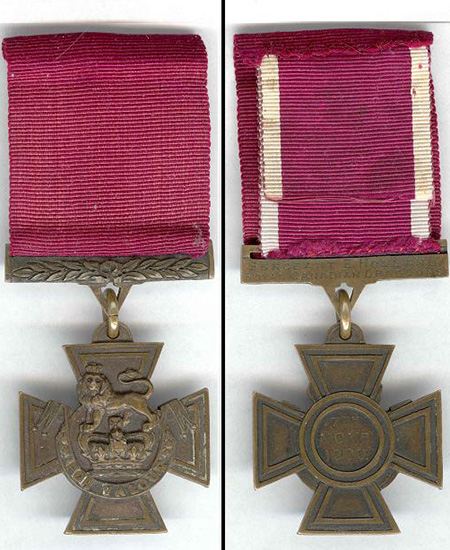
The Victoria Cross was established on January 29, 1846, and it took just over a year for the first one to be awarded. It was retroactively given to C. D. Lucas of HMS Hecla for his acts of heroism during the Crimean War, in which he carried a live (but undetonated shell) from the deck of his vessel to toss it overboard.
Given the fact the medal was named after Queen Victoria, she chose to rename the original title, which used to say “For the Brave”. The Queen altered this to “For Valour”, because she believed that others may feel alienated as not being considered “brave”. The first Victoria Crosses were constructed from metal from a captured Russian canon at Sevastopol (in the Crimean War). To date, 1358 medals have been awarded.
Soviet Union
Hero of the Soviet Union was previously the highest distinction given in the Soviet Union. Unlike some other awards, which could be restricted to just one person, Hero of the Soviet Union was awarded personally and collectively for heroic feats. Another interesting point was that it could also be awarded if a person was a foreign citizen. By becoming a Hero of the Soviet Union, a person also simultaneously received the Order of Lenin (2nd highest award), and a Diploma of the Presidium of the USSR Supreme Soviet.
If you were heroic enough to be awarded the medal twice, you would also get another Gold Star medal. However, you would not receive a second Order of Lenin. Instead of this, the recipient would have a sculptural bust built in the town of their birth.
"Golden Star" medal of the Hero of the USSR with N473. Credit to Iva Dubasov
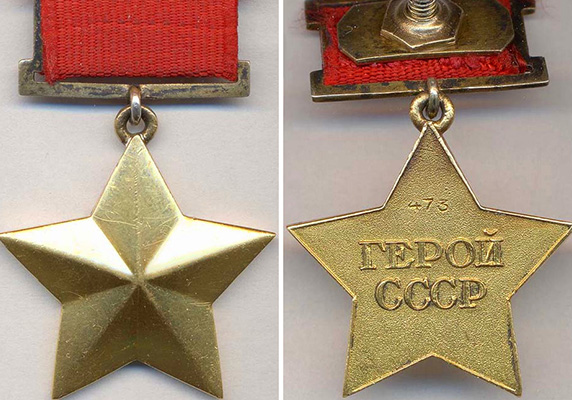
The medal itself was established on April 16 1934, and was first awarded just four days later on April 20. Until the Hero of the Soviet Union was abolished in 1991, around 12,600 people received it—however, in 1988, the USSR abolished the fact that you could receive the medal on more than one occasion.
The Hero of the Soviet Union medal is made of gold, while other parts are silver, covered in gold. A recipient also gained special privileges, such as a pension with survivor benefits in the event of their death, first priority on a housing list, 50% rent reduction, reduced taxation rates (changed in 1985 to tax exempt status), and much more. In 1991, this medal was abolished and replaced by the Hero of the Russian Federation.
Marshal Georgy Zhukov (center) wearing three Hero of the Soviet Union medals and Marshal Konstantin Rokossovsky (right). Credit to Library and Archives Canada
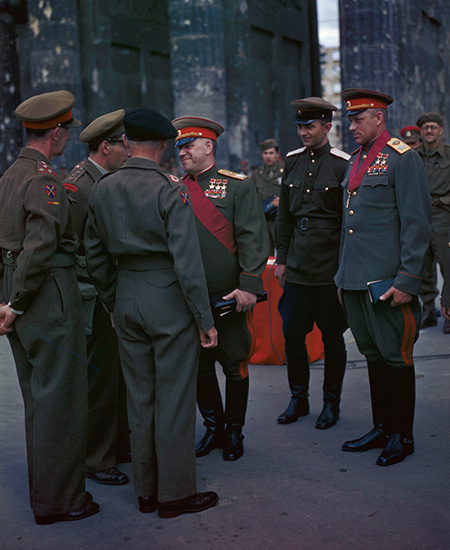
U.S.A
The Medal of Honor is the highest award across the Navy, Army, and Air Force, awarded for personal acts of valor which go above and beyond the call of duty. The medal is bestowed up a person by the President themselves in the name of the U.S. Congress only to military personnel. As mentioned previously, though this medal is the highest ranking above the three military branches, it does differ depending your respective branch.
Originally, the Medal of Honor was created by the Navy in 1861 and called the “Medal of Valor”. Around a year later, the Army created their own version: the Medal of Honor. This latter medal was for those who distinguished themselves by "conspicuous gallantry and intrepidity" fighting for the United States.
English: The Medals of Honor awarded by each of the three branches of the U.S. military, and are, from left to right, the Army, Coast Guard/Navy/Marine Corps and Air Force. Credit
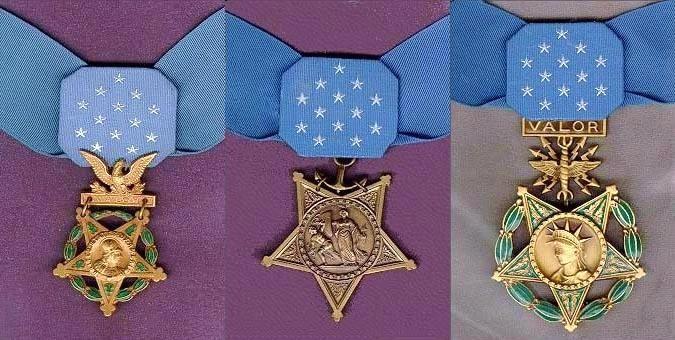
As the medal is bestowed in the name of congress, it’s sometimes referred to the Congressional Medal of Honor. If you’re a recipient, your ceremony usually takes place at the White House, while posthumous recipients are made to the primary next of kin. Since its inception, the Medal of Honor has been awarded on over 3500 occasions—just under half of these awards happened during the four years of the American Civil War.
President Calvin Coolidge bestowing the Medal of Honor upon Henry Breault, March 8, 1924. Credit to Library of Congress
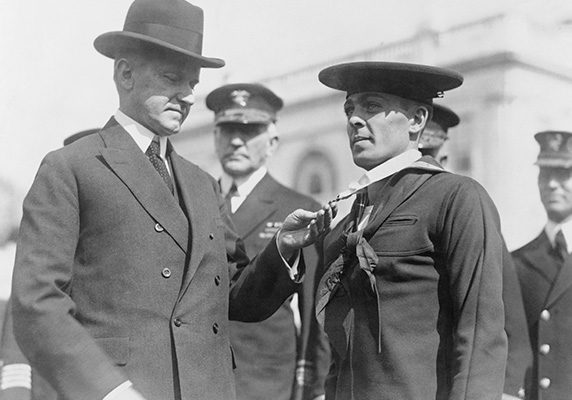
Germany
While there have been a number of high-ranking German medals, we’ll focus on the Knight's Cross of the Iron Cross, because it was created and disturbed during World War II. The medal was established on September 1 1939 and first awarded that month. Known more simply as the Knight’s Cross, it was a grade of the 1939 version of the Iron Cross, which dated back to 1813. The medal recognized extreme battlefield bravery or outstanding military leadership during World War II. Technically, it wasn’t the highest—that was the Grand Iron Cross. However, that award was only given once, to Hermann Göring, by Hitler, for building up the Luftwaffe and serving as commander-in-chief.
Knight's Cross of the Iron Cross (from September, 1st 1939). Credit to Bruce Marvin
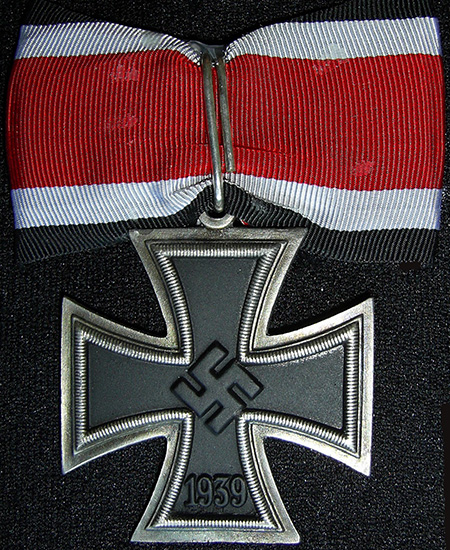
The Knight’s Cross could be awarded to all German soldiers, as well as those from other Axis countries. As mentioned, the medal was first bestowed on September 30, following the Invasion of Poland, beginning World War II in Europe. As recipients distinguished themselves further, other, higher grades were added. This included the Oak Leaves to the Knight's Cross of the Iron Cross in 1940, plus several more over the years.
Presentation of the Knight's Cross in the field to Johannes-Matthias Hönscheid. Credit to German Federal Archives
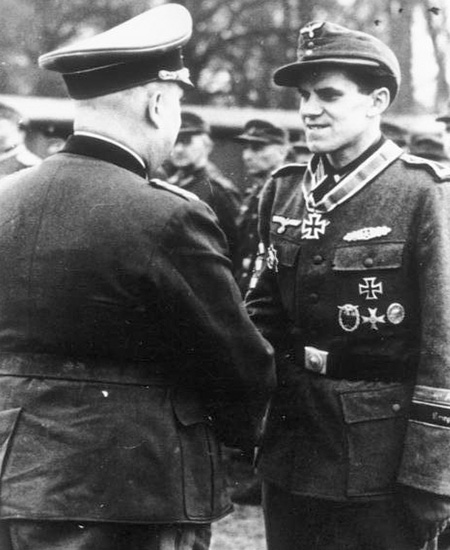
The last legal presentation of the medal had to be made before 23:01 Central European Time May 8 1945, when the German surrender became effective. However, a few more were made after the date, the last being June 17 1945. Over 7000 medals were given out during the period of its use.
That’s it for the first part of the list. In the later list, we’ll look at Japan, China, France, and more.